
We don’t often look at the television, but when we do, we do it in foreign countries. Wouldn’t you know it, we turn on the TV for the first time in Copenhagen just before leaving Denmark, and there’s Lærke Bagger, the author of a book about knitting we’ve been seeing all over Copenhagen. It’s even in the window of the 2nd yarn shop we visited on our first day here. Something else about our first day that relates to this image: in the background near Lærke, you might spot the Burger King sign; that was where the vegan demonstration we followed yesterday ended up.
Two days ago, I was kvetching about the crass behaviors of Americans; today, I’ll lean into a stereotype about East Europeans. At breakfast, as in so many other places, the people from Slavik countries have the loudest ring tones while nobody else’s phones around them make a sound. I’m likely a bit grumpy as we got in late last night, around 11:00 pm, and were too tired to deal with packing, so we were taking care of that after sleeping in a bit. This has the effect of us leaving Copenhagen about an hour later than I’d hoped for.
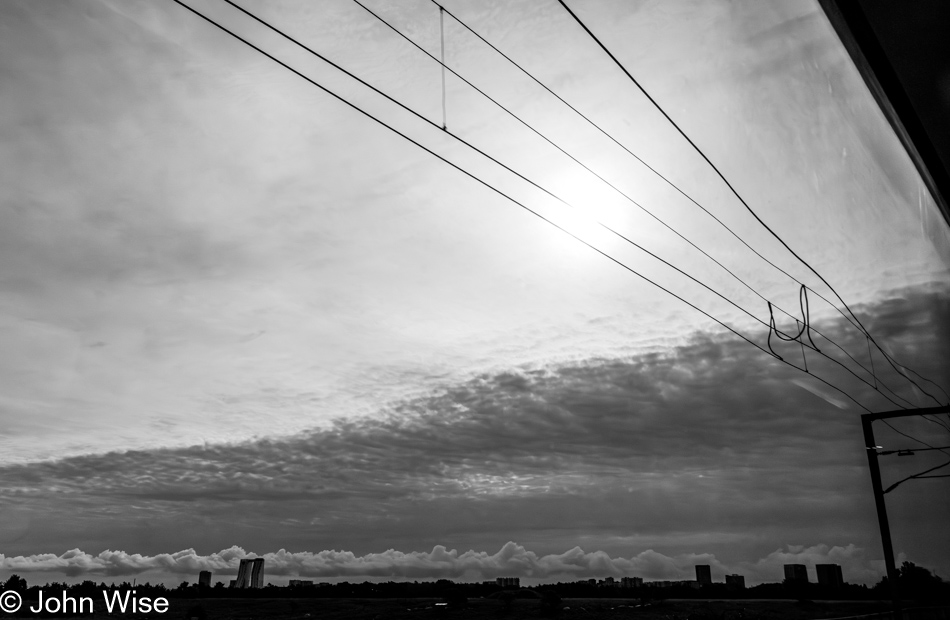
Our last morning in Copenhagen is like the last day most anywhere: we’re sad to go. From Orientkaj, we need to make our way over to Østerport station, where we’ll board a train to Malmö, Sweden. Ahead on the M4 line, we see the 2nd most frequented station of our time here in the Danish capital: Kongens Nytorv, or the King’s New Square. Now, consider the 1939 RKO film King Kong; it seems to me that this was a sly usage of Danish for this American classic film, meaning King of Kings.
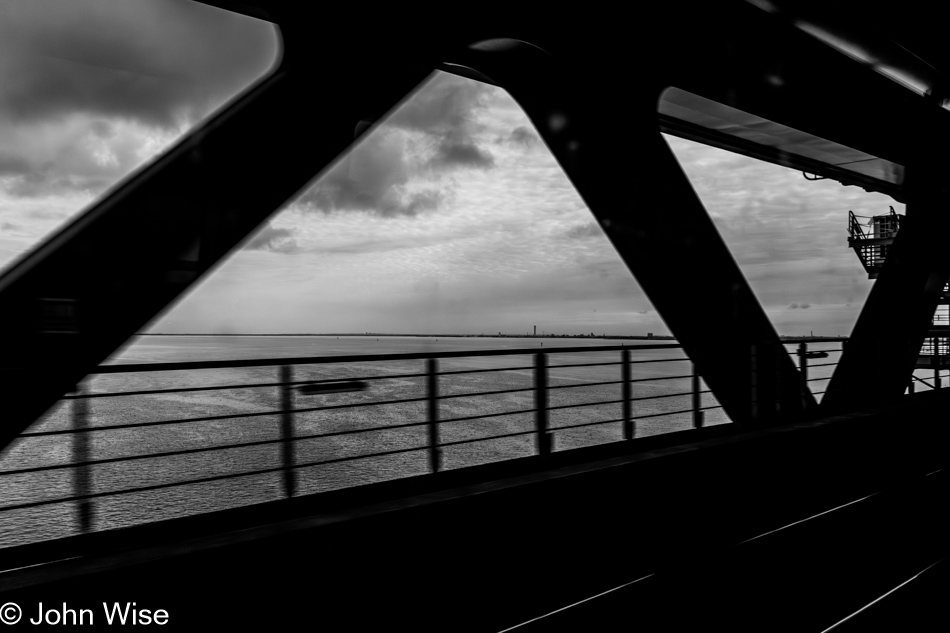
While out here on the Øresund Bridge, it occurs to Caroline that the Danish word “Bro” translates to bridge; I wish I could reconcile this with the American version of bro, which is English for douchebag. In this usage, bro is an intellectual hindrance to moving over an impasse of the mind; he specializes in being an obstruction, a kind of stench that is difficult to navigate around or clean away.
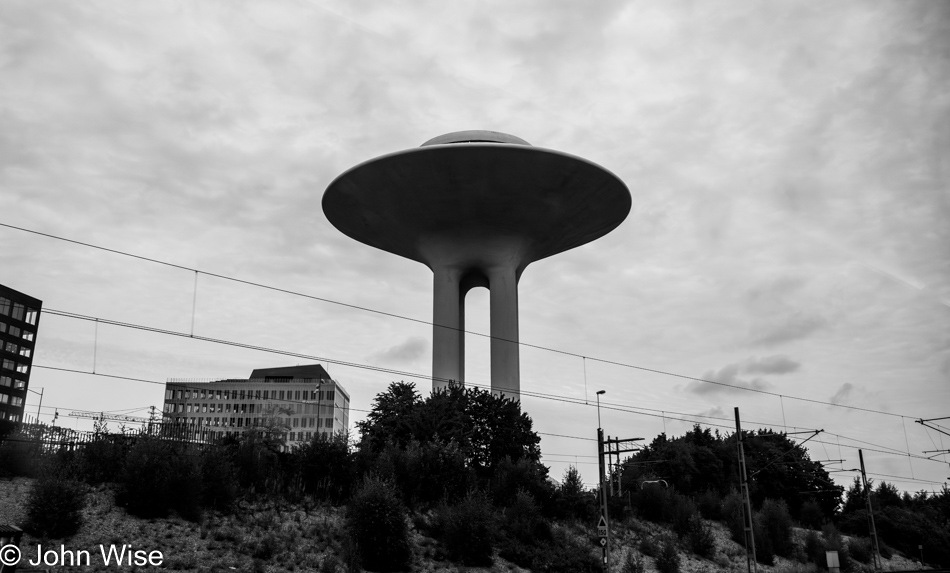
Under the alien spaceship disguised as the Hyllie Water Tower on our approach to Malmö, two Bulgarian bros who’ve been loudly Facetiming somebody somewhere else with their phone speaker on full blast were controlled for tickets. It turns out they were supposed to exit the train at the Copenhagen Airport in Denmark but were so busy being self-absorbed in their performance of annoyance that they missed their stop and were about to be escorted from the train here in Sweden, but not only that, they were riding without tickets which comes with a fine of between $72 and $135 per person.
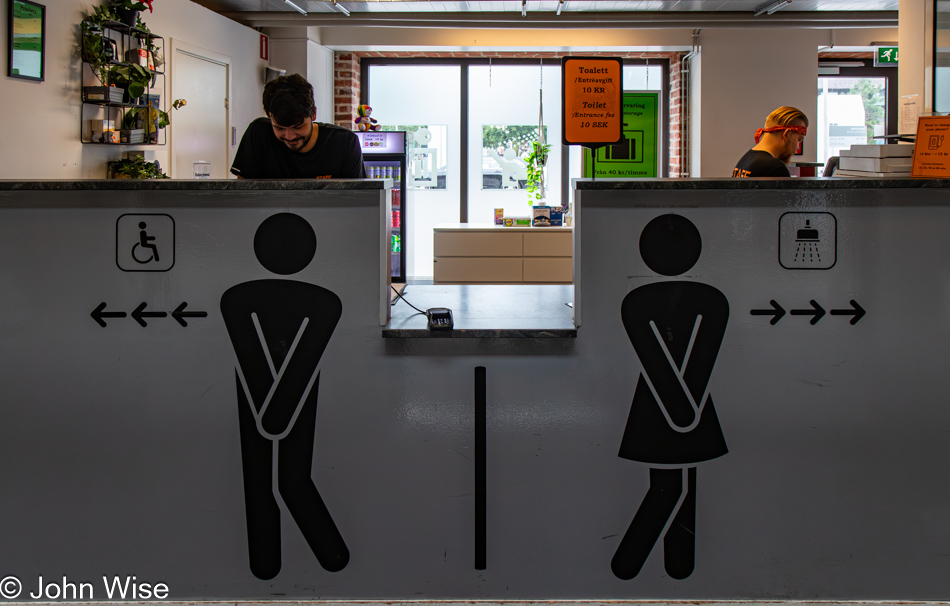
Even peeing in Sweden isn’t cheap at nearly $1.00 per person, but when you’ve got to go, you gotta go. Our first stop in the station before finding the toilet was over at the baggage storage lockers that are coming in handy for our brief four-hour visit to Malmö. Note the credit card reader – no need to carry cash for even the smallest amounts.
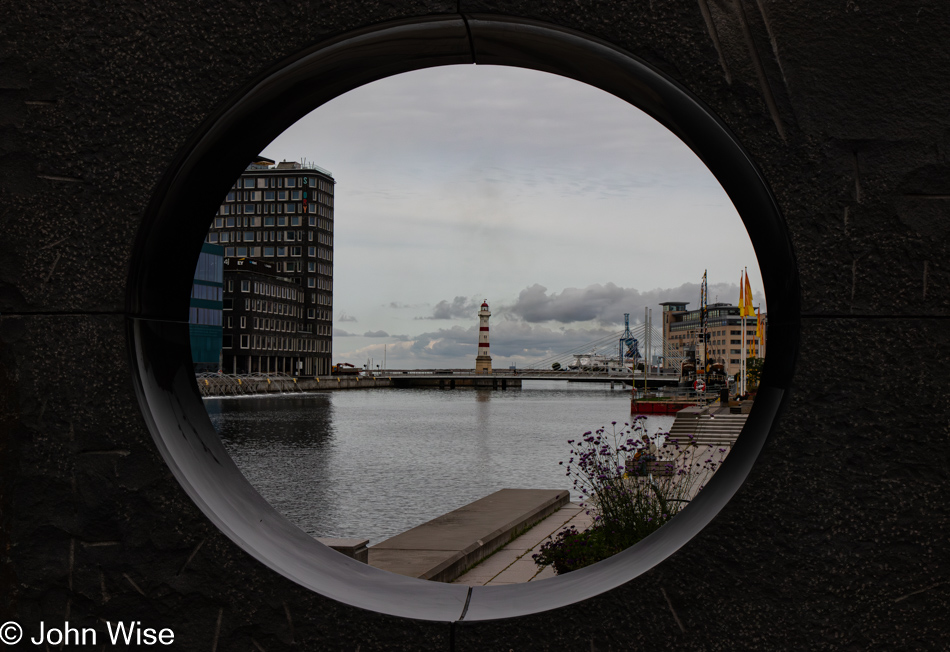
A few steps out of the main station and we were immediately drawn to this lighthouse which turned out to be in the wrong direction of where we should be going. With such a limited amount of time, we have to make each minute count in considering what and where we’ll be doing stuff. The first thing stricken from our itinerary was a visit to the local yarn store, but we have more than a few left to visit over the coming two weeks. Trying to get closer to the lighthouse, we continued in the wrong direction until we reached the bridge down there, turned left, and left again to walk back up the canal.
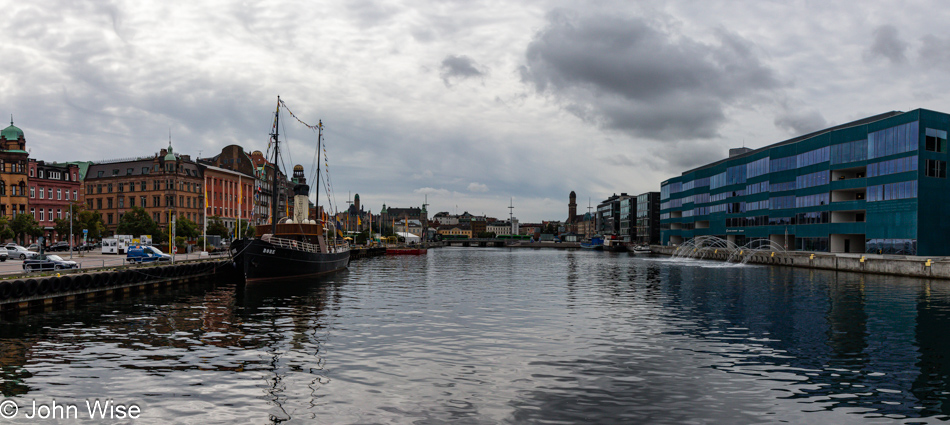
This is the view from that bridge I just mentioned. The sculpture I photographed the lighthouse through is way down there by the other bridge.

This sticker and the advertising campaign for Baden-Württemberg (the German state where the famous Black Forest is located) must be one of the most successful viral campaigns ever created as we’ve seen this, “Nice here. But have you been to Baden-Württemberg?” all over the United States.
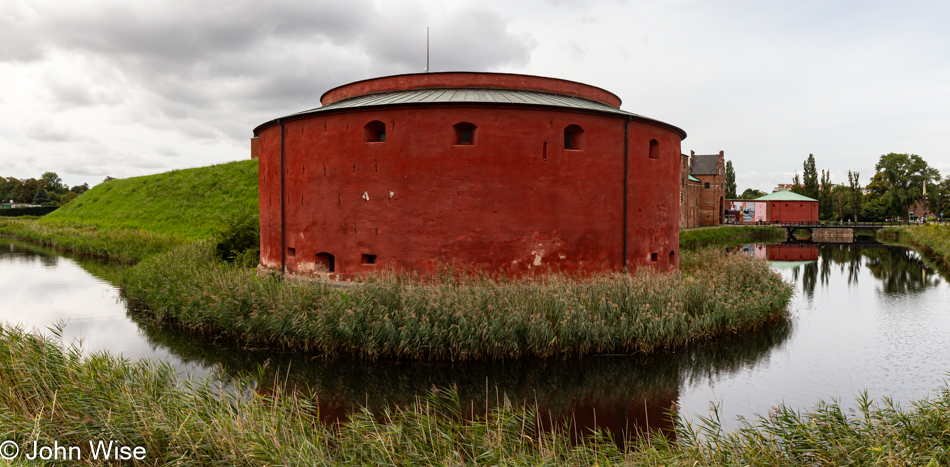
I’ll get this out of the way right now: our choice to visit the Malmö Castle and Museum wasn’t the greatest decision. In retrospect, we should have gone over to Södra Yarn, hung out at Lilla Torg (the Small Square), and grazed the various foods at Saluhall (Market hall), but one can’t tell when planning from 6,283 miles away and not knowing anyone else that’s been to this corner of Sweden.
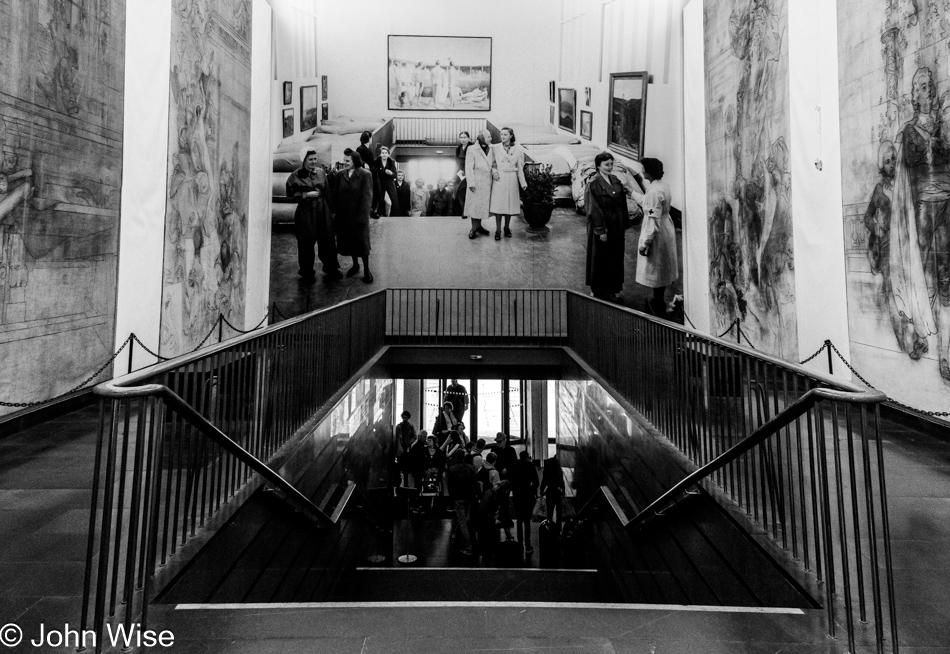
Don’t get me wrong, visiting castles and forts is typically great, but there’s something about the Malmö Castle and Museum that seems to lack focus, though we will learn a few things about the history of the place. The first castle on this site was founded by King Eric of Pomerania, who ruled over the Kalmar Union (the combined kingdoms of Denmark, Sweden, and Norway) after the death of his great-aunt, Margarethe I, so there’s that connection to history. One hundred years later, that castle was torn down, and King Christian III of Denmark built this one. Subsequently, it was used to imprison James Hepburn, 4th Earl of Bothwell, third husband of Mary, Queen of Scots. From the photo in the background, you’ll see refugees arriving from German concentration camps near the end of World War II who would stay at the castle during a transition period.
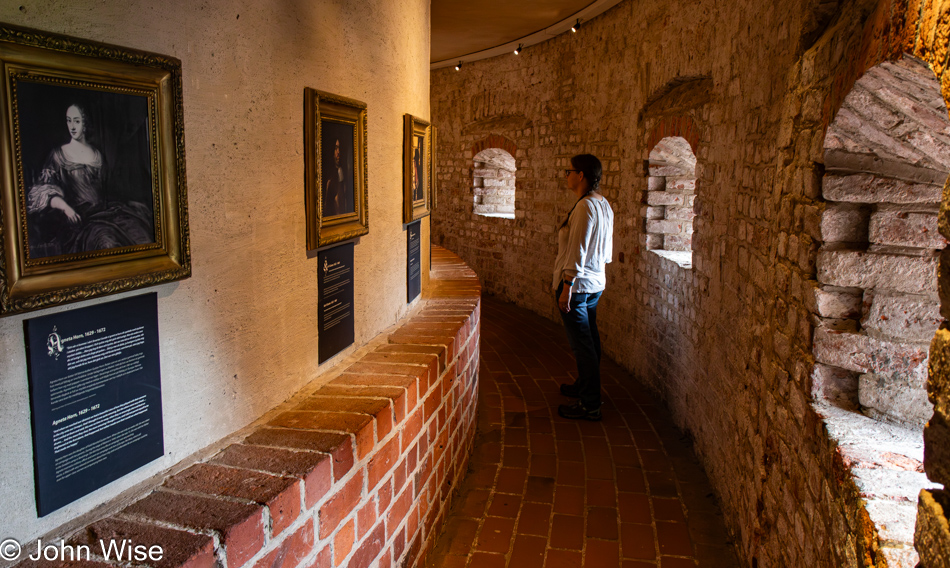
A bit of a strange layout and a randomness about where things are. On our way in, we passed an exhibition featuring modest clothing for women with details about the global demand and examples of such things as sports clothes that incorporate hijabs, abayas, and tunics. After that, we enter this turret that is sparse in information about its history.
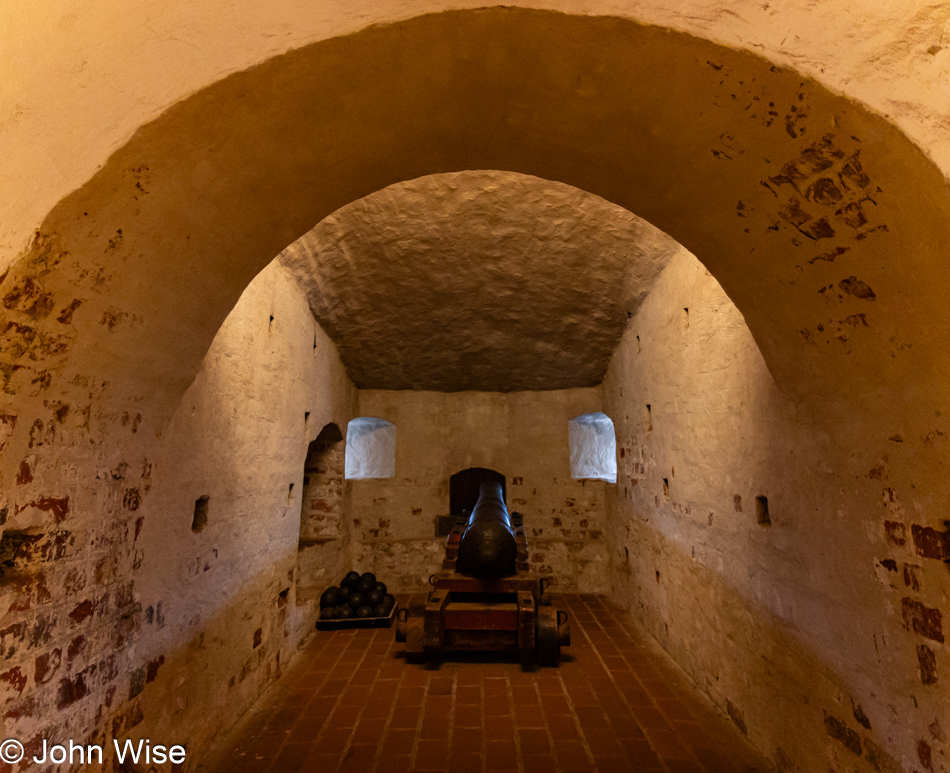
There are two of the turrets still existing but from the grounds, it appears there once had been four. There also appears to be far more to the castle than the small part we are allowed to visit. I should understand this as during my first visit to Versailles Palace, the majority of it was off-limits, and as I’ve seen from the old mansions in the Eastern United States, especially the Newport, Rhode Island area, mansions, forts, castles, and palaces are extremely expensive to maintain and is it not always possible to find organizations that are willing to add to an inventory where budgets are already stretched.
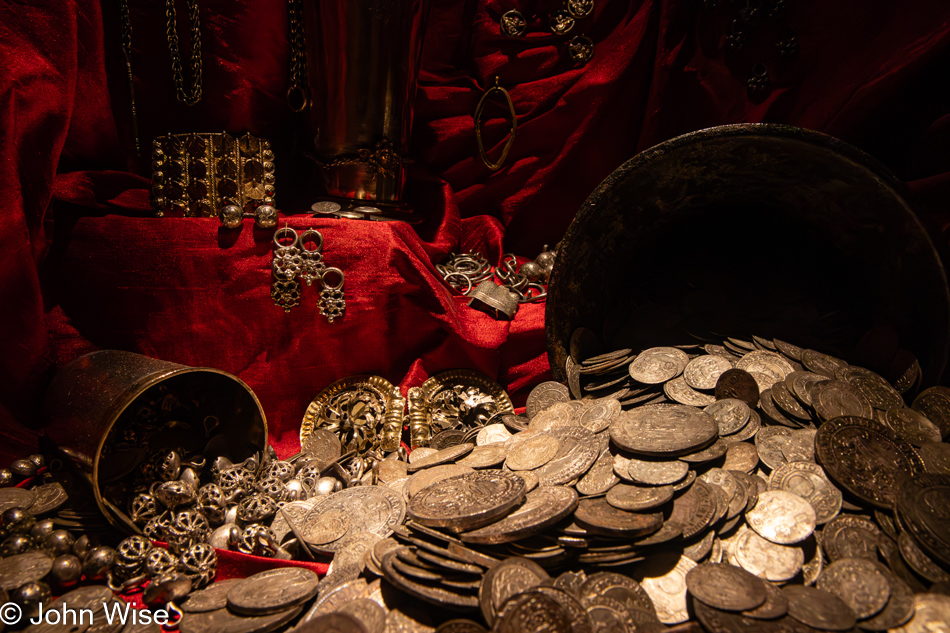
A wealthy brewer from Malmö named Anders Christensen buried a silver hoard during the siege of 1677 to protect his riches. He and his wife died with his treasure lost, this was until 1880 when it was rediscovered.
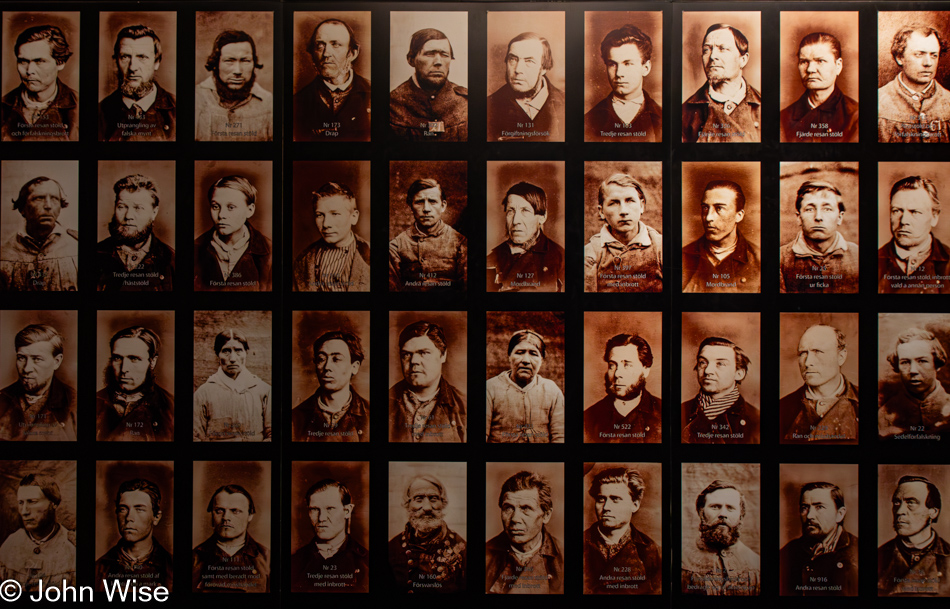
For a long time, the castle fell out of use until 1828 when it was turned into a prison until 1909. These are some of those prisoners.

Due to the years of neglect and then use as a prison, there’s really nothing left that exemplifies how the castle was once used by royalty. In the scattered approach as to what the museum should function as, there’s even some art here, such as this etching from Francisco de Goya.
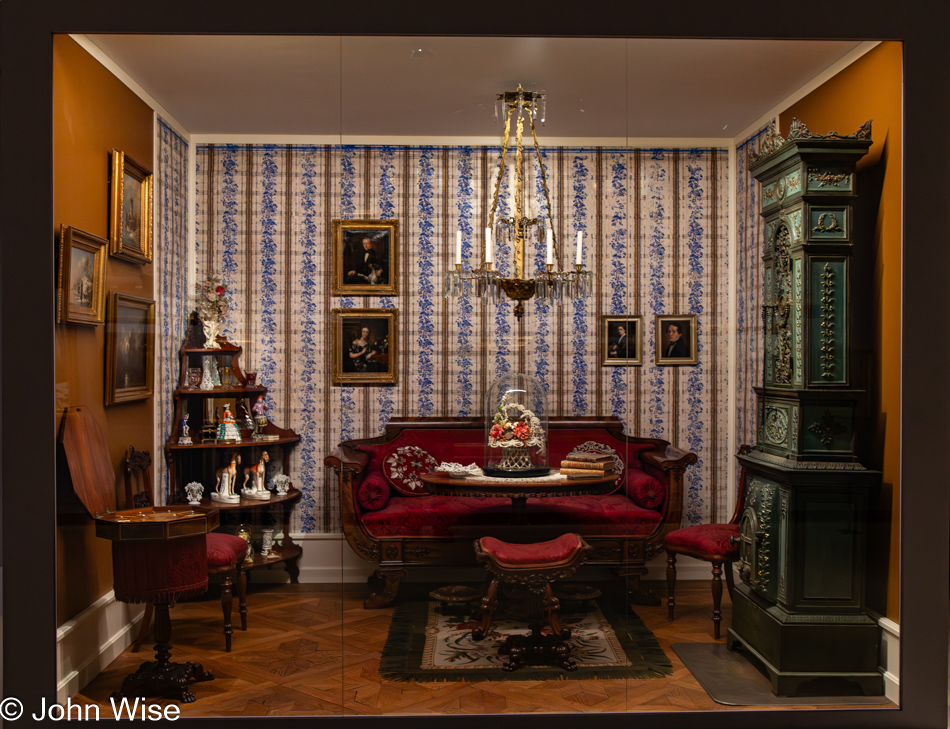
This sealed cabinet display is called the Apolloff Interior. In 1853, Captian Christer Frederick Abrahamsson had the furniture made for his family, which his daughter Alma Apolloff inherited. Since she and her husband never had children, they bequeathed their estate to the museum in 1928.

I want a Saluhall (Market Hall) in Phoenix that’s as amazing as this one, serving a city of only 330,000 people compared to the Phoenix Metro area of 4.85 million people. The demand for quality in other countries can be extraordinary when I consider what we have on offer back home; it’s actually confounding to me. This is the Clemens Kött & Husman meat stand that also serves hot food. On Friday, they can be found cooking steaks on their grill, but this is Tuesday, and we have something very different in mind.
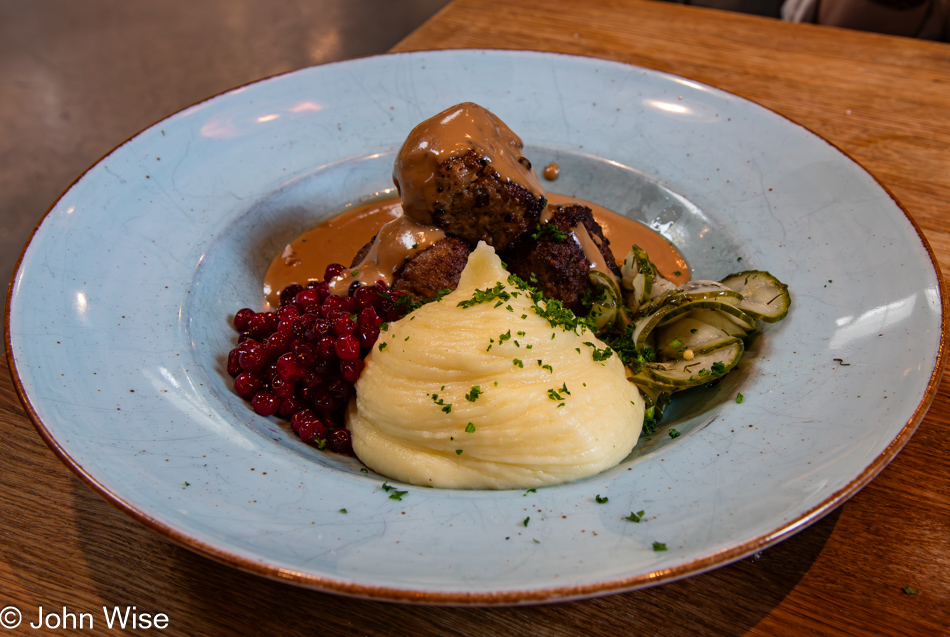
We were here for köttbullar, a.k.a. Swedish meatballs. With mashed potatoes, pickle, lingonberry, and four meatballs the first thing we learned about this traditional dish is that Ikea is ruining it. We’ll have köttbullar again on this trip, but these right here in the Malmö Saluhall will forever define what perfection is.
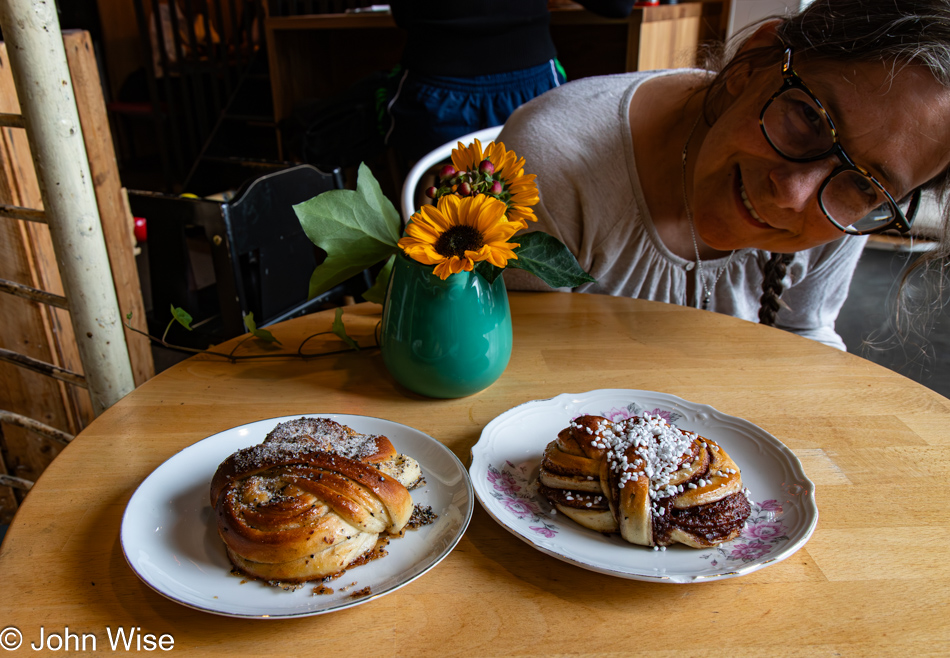
We’ve moved down the aisle to St. Jakobs Stenugnsbageri (stone oven bakery) for our first Swedish fika with our two americanos yet to be delivered. With one Kanelbullar (cinnamon) and one Kardemummabullar, we were ready to find out which one was the winner. Caroline opts for the cardamom while I lean towards the cinnamon.
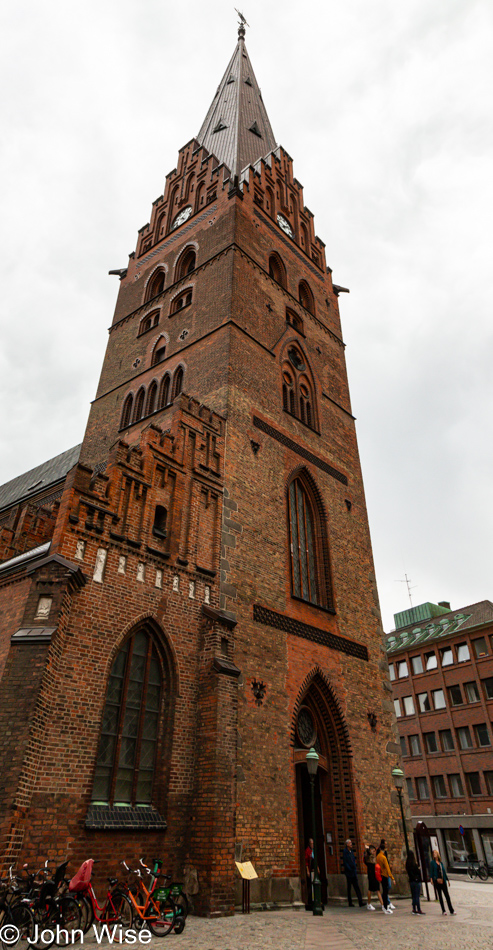
Another St. Peter’s church and the oldest surviving red brick structure to be found in Malmö. The design is thought to have been inspired by the Marienkirche (St. Mary’s) of Lübeck, Germany, which we visited ten years ago.
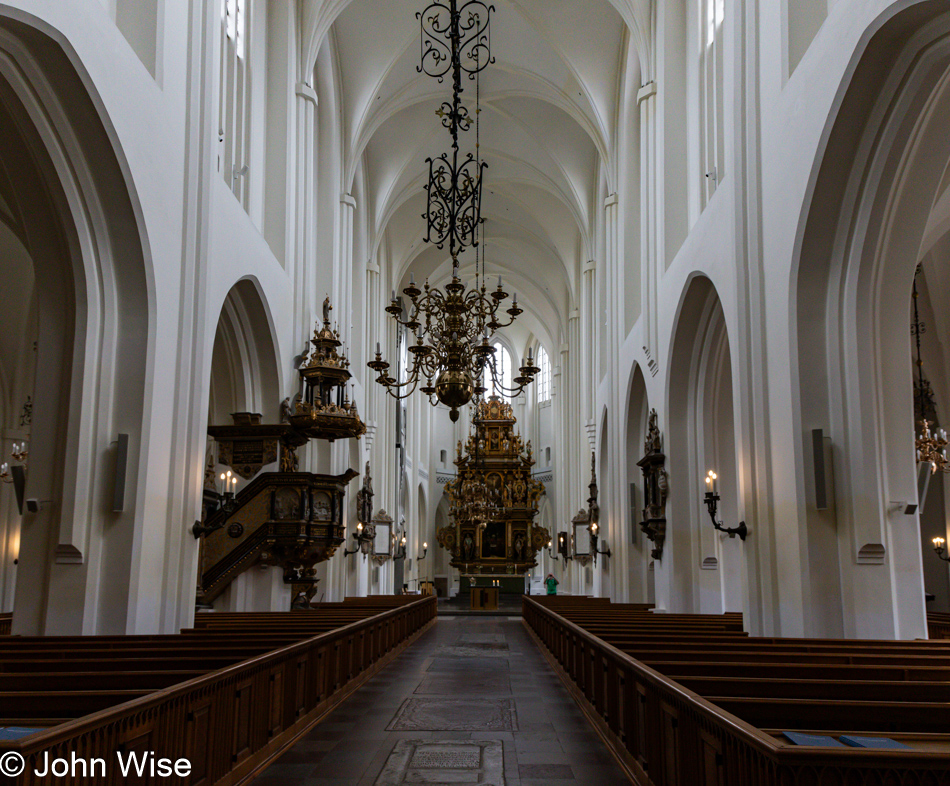
Constructed in the early 14th century, this Gothic church was built when the city, like the rest of Europe, was of the Catholic faith. I don’t believe much about the Reformation is taught in the U.S. and a brief survey in a coffee shop confirmed this thought. The idea of the relative fundamentals of religion taking a dramatic turn that would result in wars, death, iconoclasm, and societal divide seems alien, and yet here we are almost 500 years later, and some would say we are at a similar precipice due to cultural, social, economic, technological, and racial issues that are splitting societies between those who are capable of adapting with tolerance and those afraid that the changes have been an onslaught of destruction of their beliefs producing fear and anger.
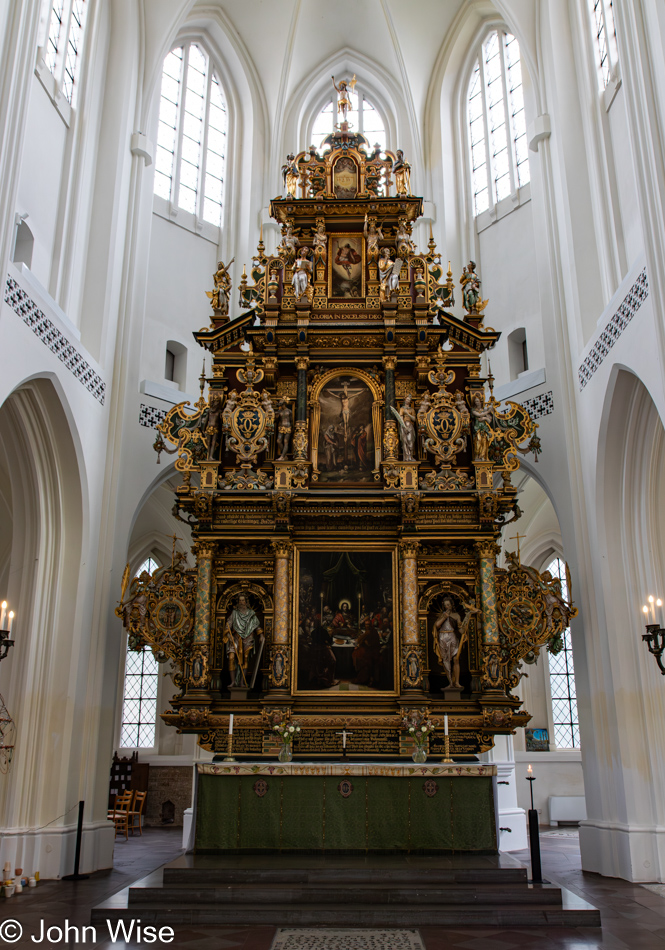
The altarpiece is from 1611, as most everything in the church had been destroyed and whitewashed in 1529 at the height of the Reformation.
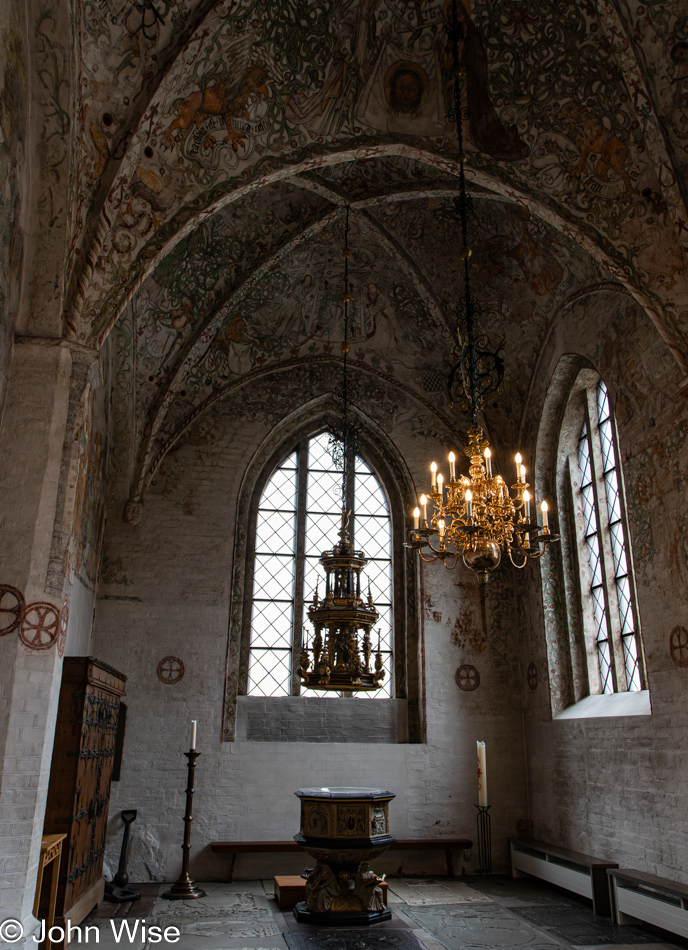
Of the five original side chapels, only three still exist, including this one dedicated to St. George but popularly known as the Krämarkapellet (Chapel of the Vendors), which was built for Malmö’s guild of cloth dealers. Notice the baptismal font and its octagonal shape, which I wrote about during our visit to the Rosenborg Castle. The murals in this chapel were also painted over like the rest of the church, but between 1904 and 1910, they were uncovered and restored.
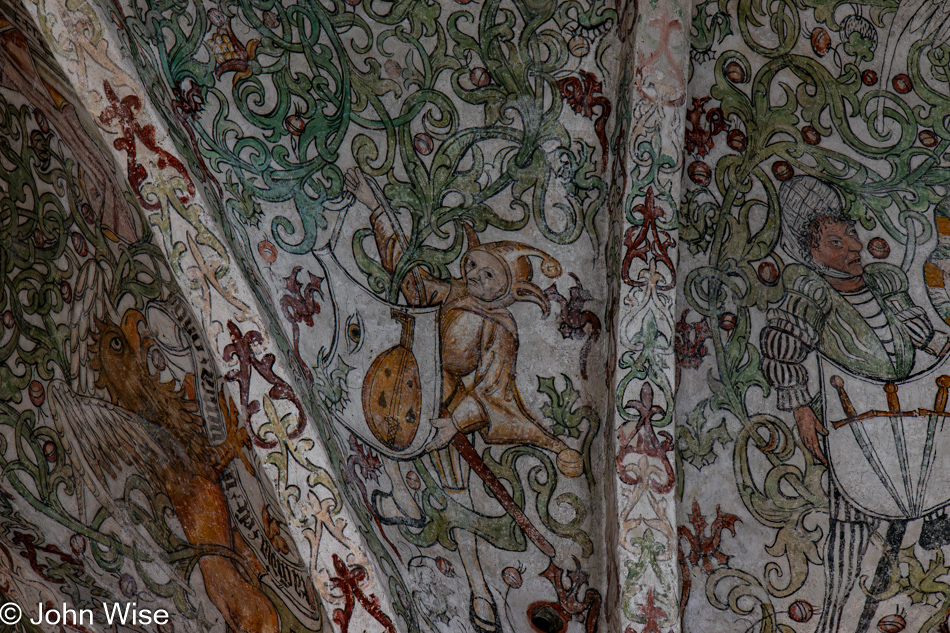
There are other guilds represented in the chapel with elements from their coat of arms; to the left, you can spot a griffin that is part of the coat of arms from the city of Malmö. I have to wonder why more of the ceiling wasn’t restored, but such is the state of things when religion is involved.
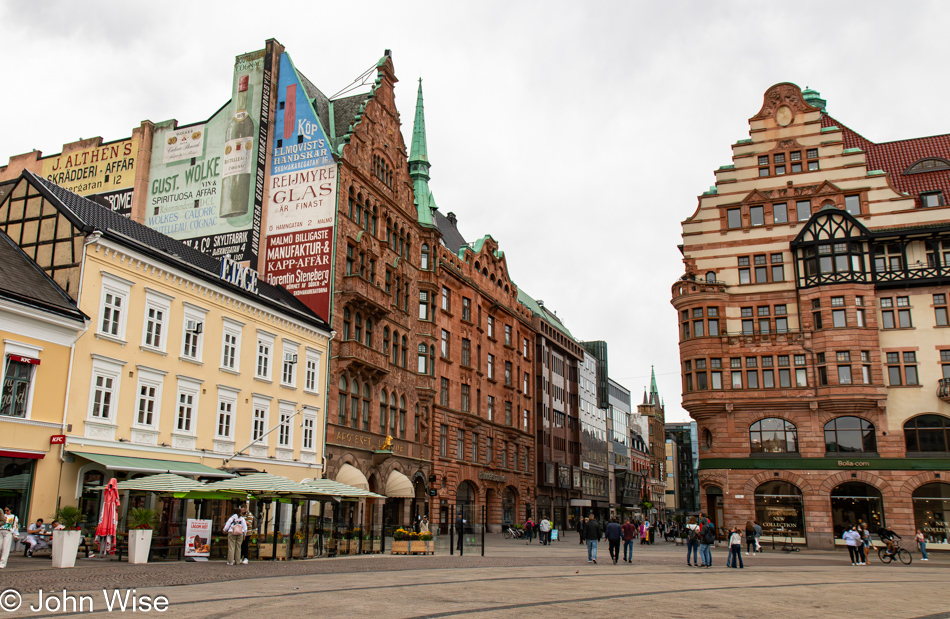
The Main Square on an overcast day is better than not visiting a main square, even when we are on the run and taking things in quick impressions instead of being able to really soak in the history of the place.

This statue of King Karl X Gustav stands in the main square and depicts a leader who apparently loved war but died at the young age of only 37 years old due to complications of misdiagnosed pneumonia instead of combat.
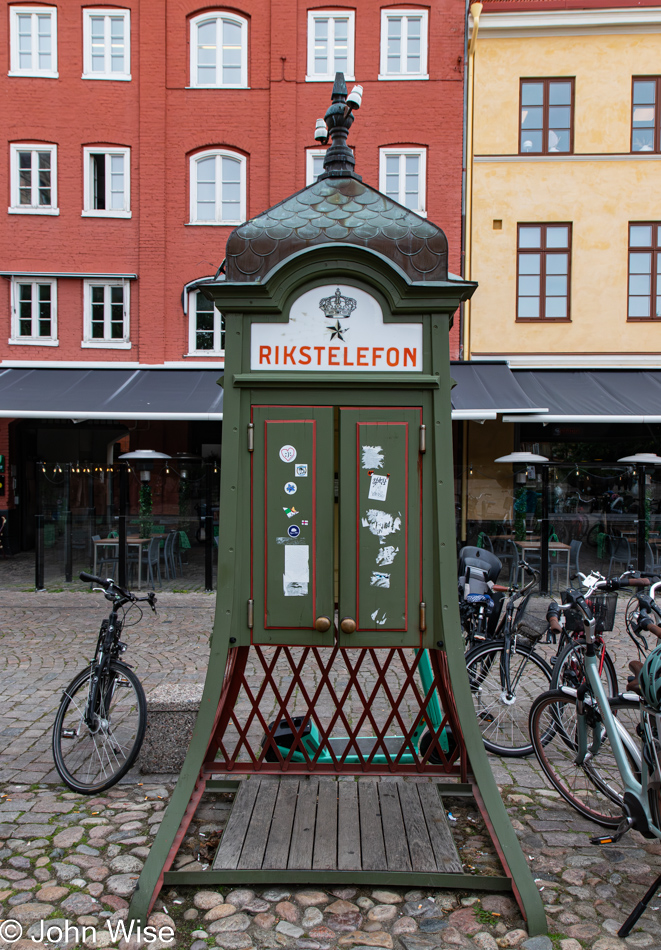
The old Rikstelefon payphone booth is no longer functional and while not as ornate as what we were seeing in Copenhagen, it’s still nice to see these relics of another age reminding us how quickly life changes.
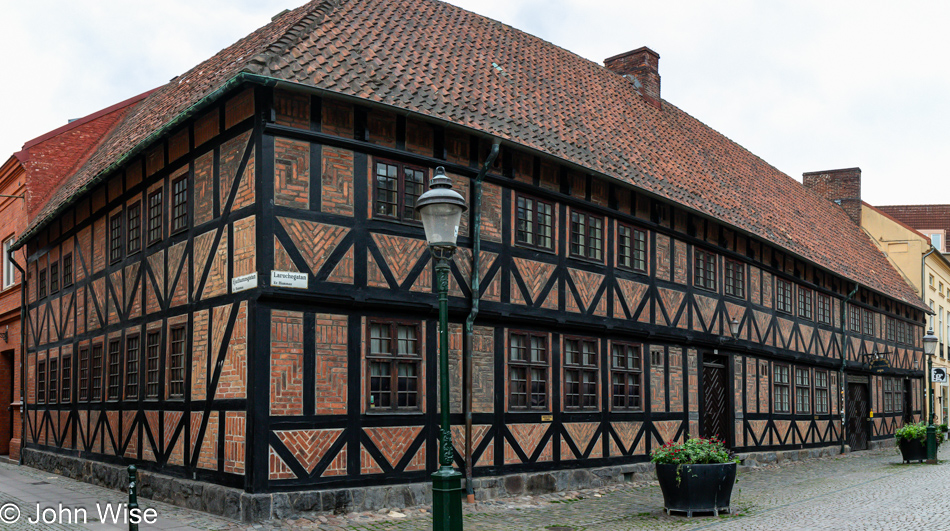
If half-timbered houses don’t instill a sense of history when visiting an old town center such as Lilla Torg here in Malmö, then nothing will. This was also the end of our time in town before returning to the main train station for our ride to Ystad, Sweden, where we’d be spending a night.
Uh-oh, Houston, we have a problem. Our bags have either been stolen, we don’t understand how to use our retrieval code, or our credit card and a different card are not able to be used here in the baggage lockers. Not only are we panicking about our bags but our train is leaving shortly. As I guard our locker, where our bags are hopefully safely stored, Caroline headed over to the toilet stall we visited earlier, looking to find someone who could help us. It turns out that the personnel at the facilities offering relief of certain bodily functions are also tasked with dealing with the faulty software that operates the baggage locker system. A couple of reboots of the software and we are in, grabbing our bags, and doing our version of sprinting to the track to hop on the train. We just made it as it turned out our train was late and were able to laugh about our small dilemma.
Except, we don’t have tickets. Well, I have the Swedish Rail app on my phone so I get busy right away buying our tickets. Good thing I was right at the moment of getting credit card authorization as a controller was moving through the train to check tickets. He could see where we were in the process and that this wasn’t a response to seeing him, so he told us he’d come back shortly to check on our progress. Everything’s good, and Caroline turns to working on my next pair of socks, and I get to taking notes.
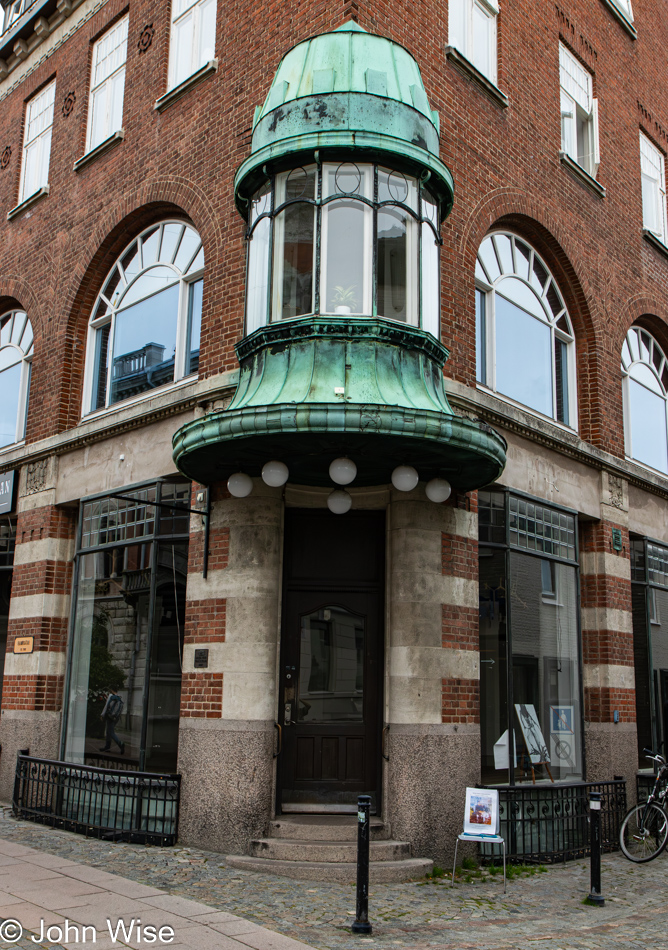
Forty minutes later, we are welcomed to Ystad by absolutely nobody. With a population of about 20,000 people, this is a fairly small town. We are down in southern Sweden on the Baltic Sea for one very specific reason you’ll learn about tomorrow. First up, we needed to drop our bags in our room at the Prins Carl Hotel, which ended up being the greatest bargain out of all of our lodgings, not because of the price alone but everything that came with our room. Checking in, Sven, the proprietor, was on hand and welcomed us with real enthusiasm. While making our reservation a month earlier, I had questions for him about restaurant recommendations and a bike rental, he was gracious with regards to both requests. The ambiance at the check-in desk and lobby is an experience in itself; let’s just say that Sven’s wife has an eye for art and strategically placed fruit.
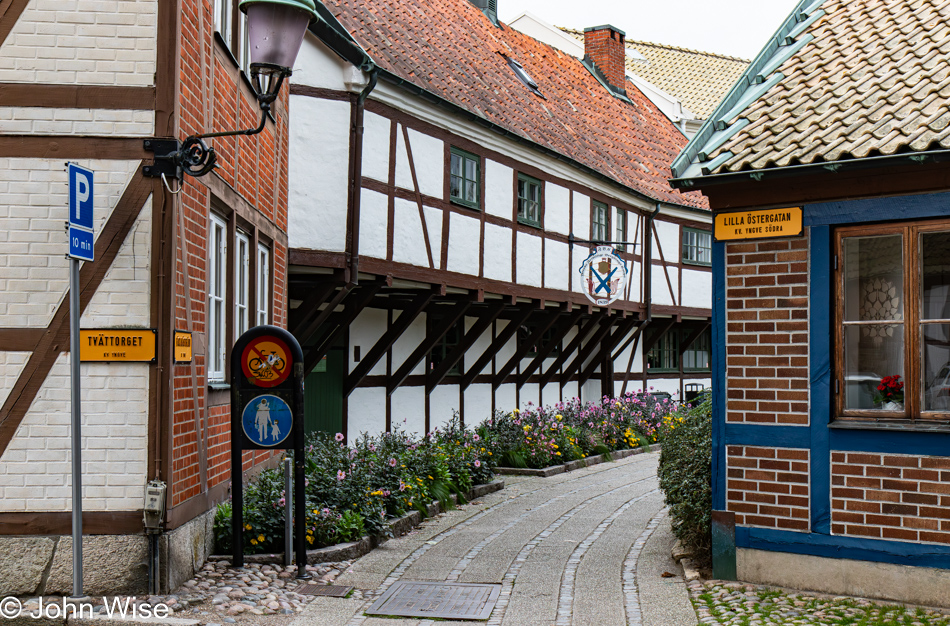
I just told you about a bike rental, and so with map in hand, we started our half-mile walk to the Gösta Svensson Cycle shop, but being John and Caroline, we’d just have to detour. We verified that they were open till 6:00 pm, but we were also on a bit of schedule because we wanted to lock up the bikes in a storage area at the hotel, and that had to be done before 6:00 also. The reason for this arrangement is that we needed the e-bikes first thing in the morning.
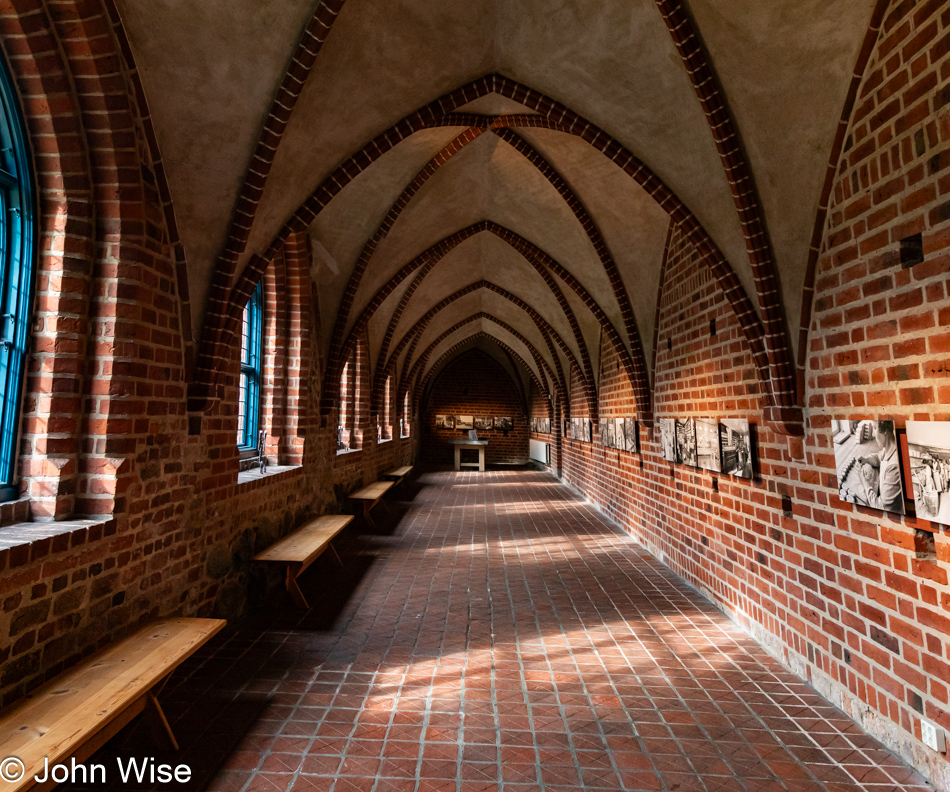
Drats, it appears that the Gråbrödraklostret (Greyfriars Abbey) and St. Peter’s Church are closed, that was until we found the right door.
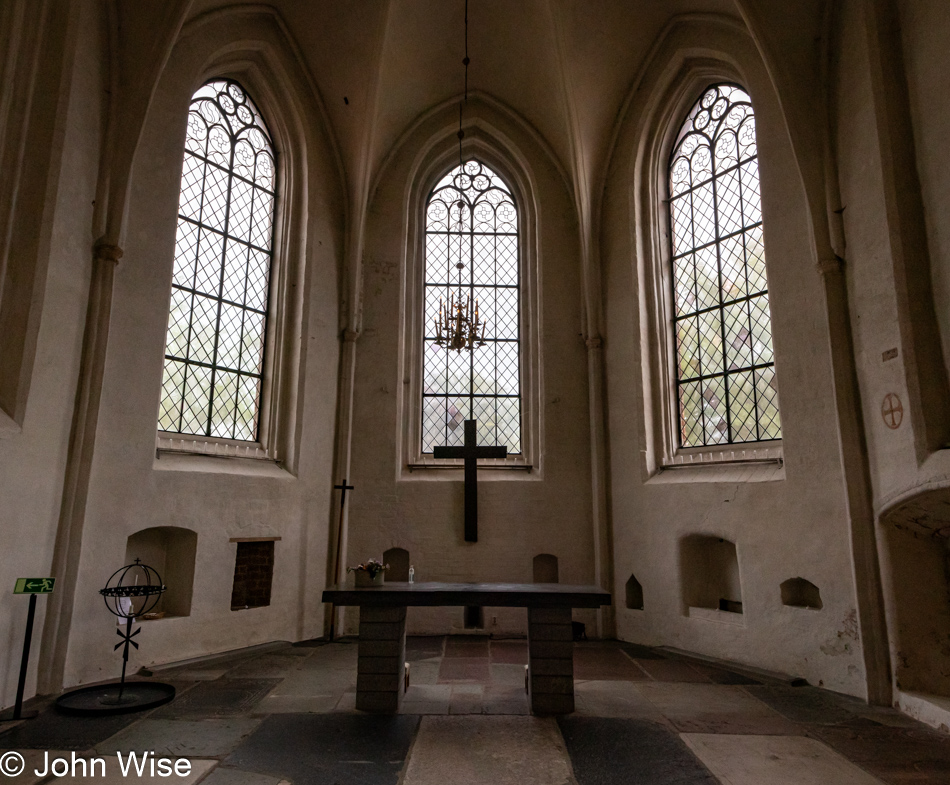
Established in 1267, you should know by this time what came around and acted to disestablish the abbey in 1532. I’ll offer you a hint: this being Sweden, it wasn’t the Spanish Inquisition.
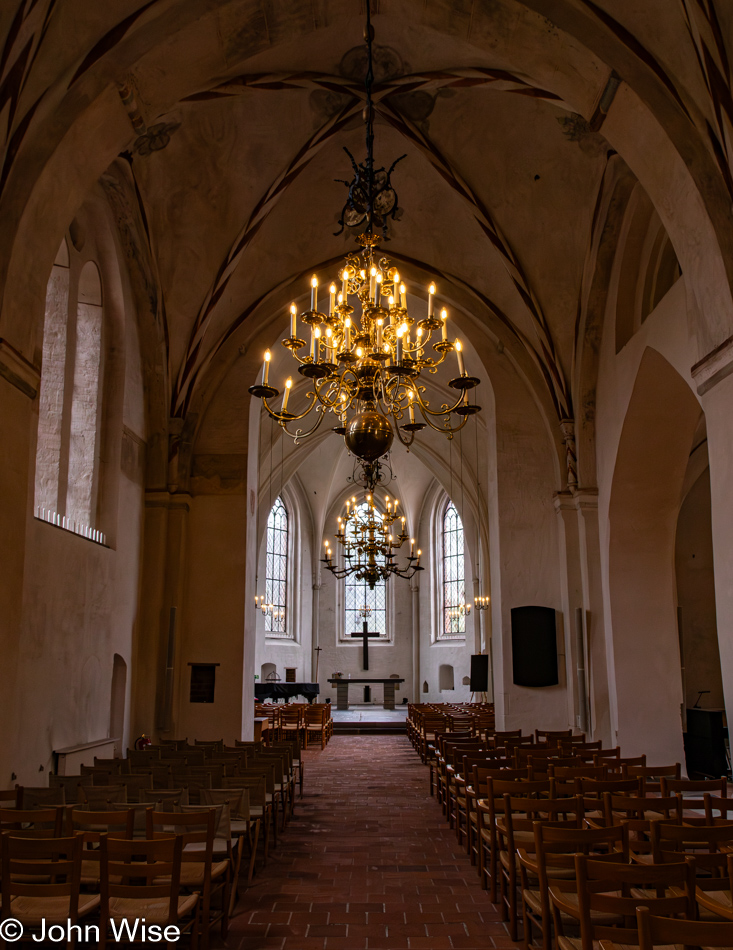
Some hundreds of years ago, the northern and western wings of the monastery were torn down, and at one point the remaining building was used to manufacture Aquivit, followed by it becoming a granary. Finally, by the 19th century, the complex was left to decay.
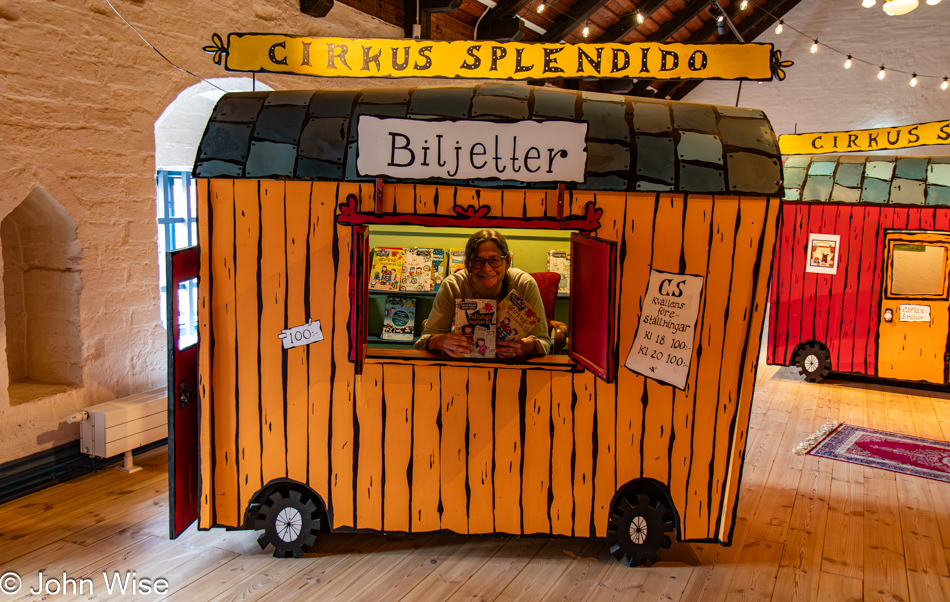
In 1909, the old abbey and church were starting to be renovated, and as you can see by the photo of Caroline, Ystad is still trying to figure out how to best make money with their historic property.
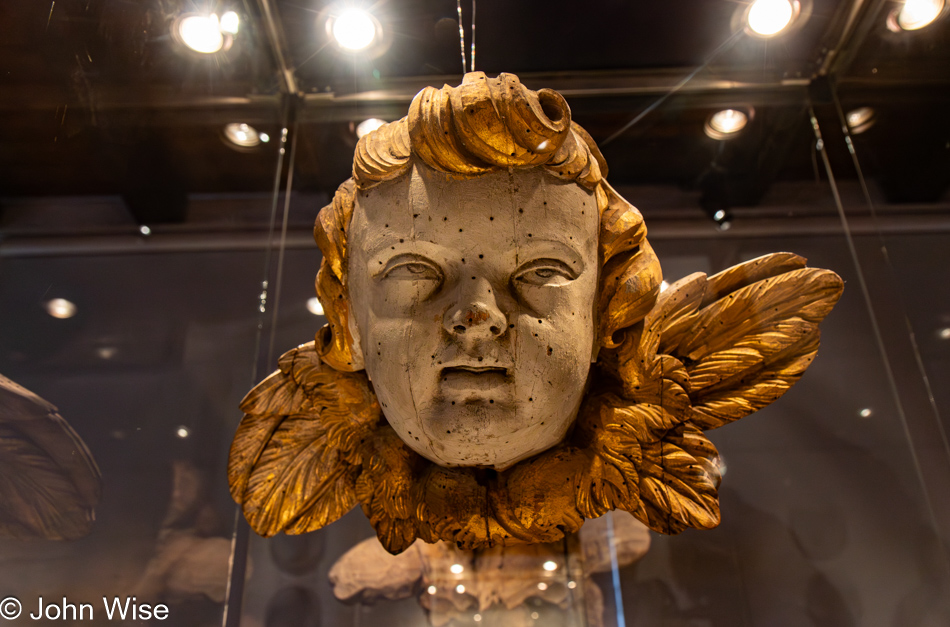
On one of the occasions that I don’t photograph the placard offering some interpretation of what we are looking at, I get home to find out that this wood carving of a baby angel head has never been shared on the internet before; how can this possibly be? As I stare at this baby with stoned, sleepy eyes, I can’t help but think how cool it would be to convert a cathedral loaded with religious iconography into a psychedelic experience with celestial video projections on the ceiling above the nave while the sounds of gods and angels talk to adherents of the trippy sitting comfortably in recliners instead of the hard pews. Maybe I’m too old at this time, but this would have been my ultimate Disneyland/Cineplex about 30 years ago.
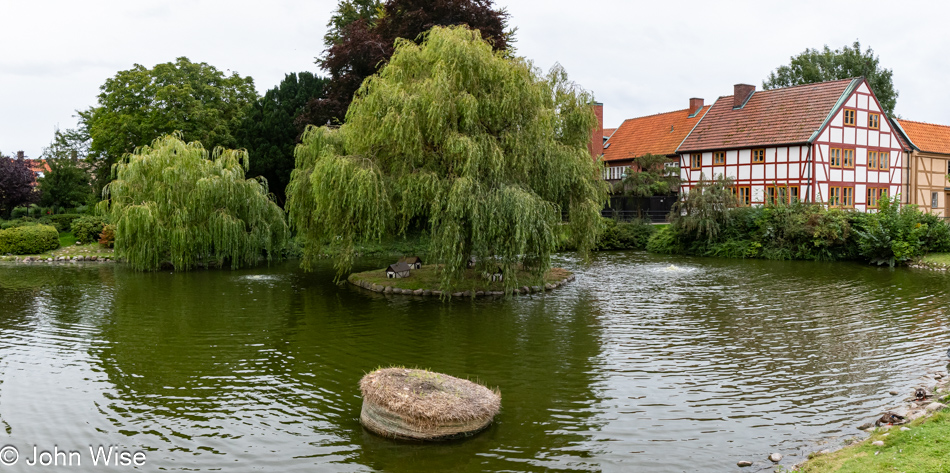
We left the church and finished our walk across town to the bike shop. For one reason or another, I got the owner’s e-bike, which was nearly brand new, while Caroline was using one of the shop’s e-bikes, also in immaculate condition. If only there were enough time left in the day before the Prins Carl lobby closes, we’d have taken a ride around town and up the coast but so it goes.
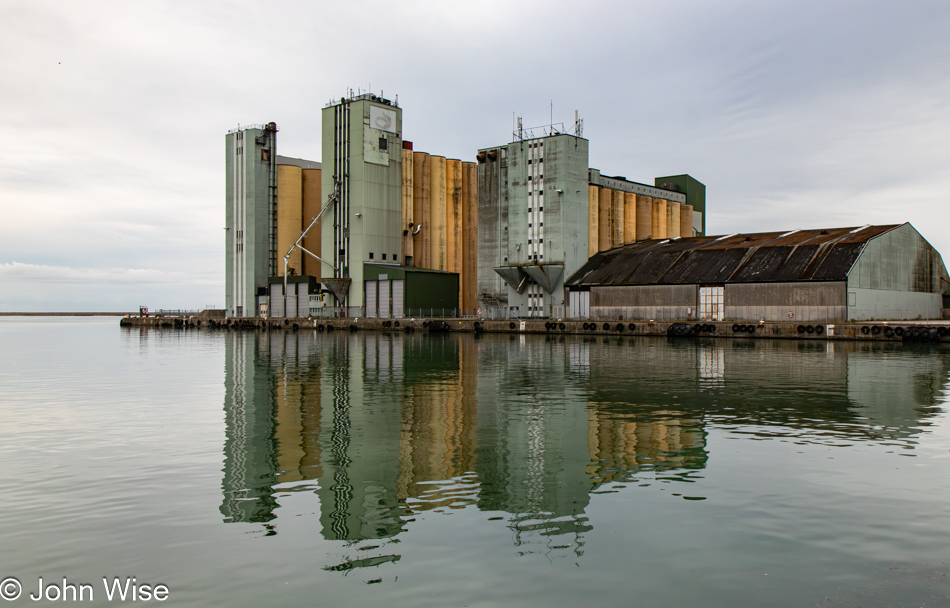
With the bikes secured, we went out for a walk in the direction of the harbor, walking past the ferries that shuttle visitors to and from the Danish island of Bornholm and further on to Poland.
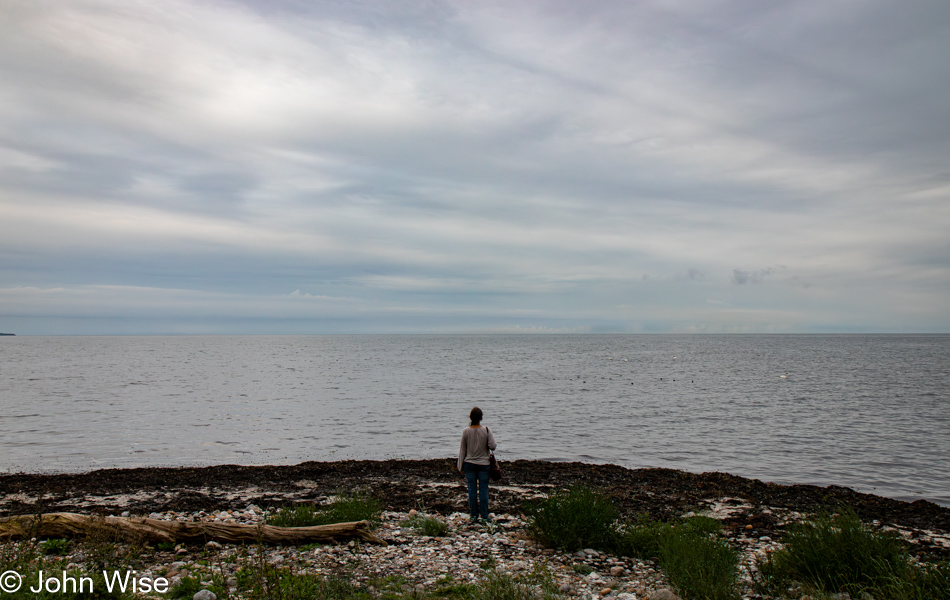
Just 552 kilometers (343 miles) out over the sea is Binz, Germany, on the island of Rügen which we visited just a couple of years ago. A bit further on to the left is Poland, an occasional adversary but, more recently, an important trading partner. We are currently standing at Engelska Bryggan (English Jetty), where the rotting seaweed is giving off a distinctly sulfurous smell and not in that almost pleasant Yellowstone kind of way.

The map said the road goes this way; this hasn’t been a road in a long time, but it sure is a scenic path.

As Caroline scoured the map for our way back to where we’d have dinner, she recognized a spot on the map that made note of fictional detective Kurt Wallander’s house. While neither of us has ever seen the show, we still swung by, so when we get home and watch a clip or two, we can say that we’ve been there.
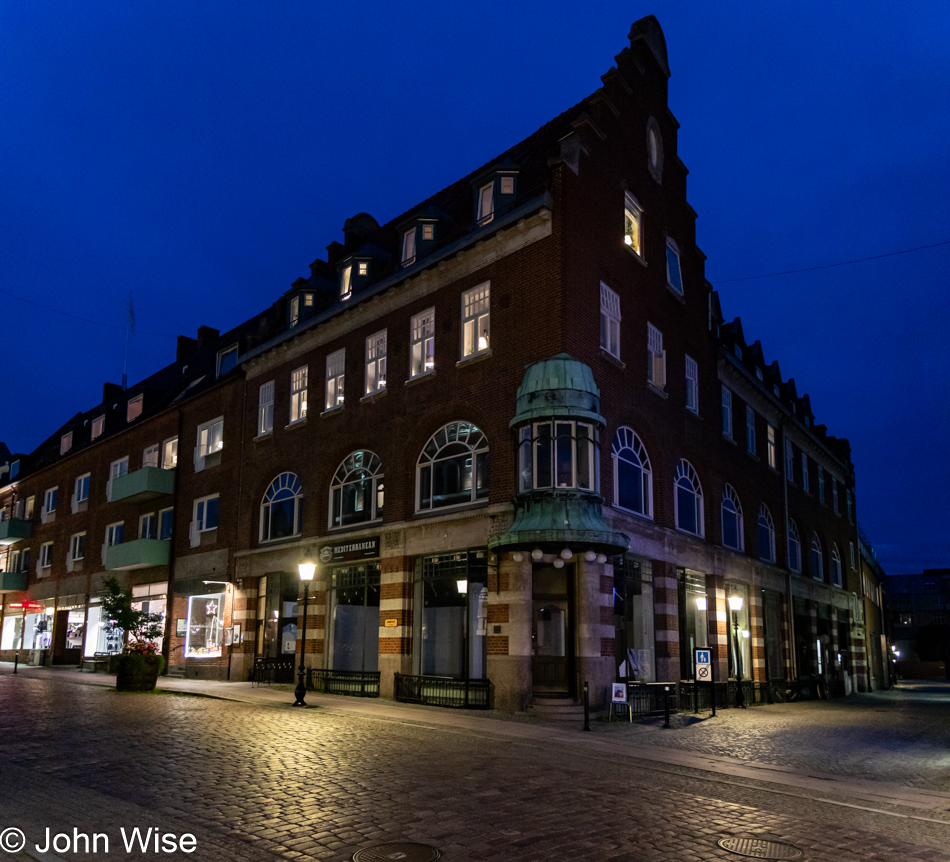
This is right where we’d live up on the third floor if we could live in Ystad. The prices are reasonable, but in such a small town, speaking Swedish would be mandatory. While the place has a kind of Binz, Germany, kind of vibe, there are very few people on the streets, and one gets the impression that the economy is suffering, thus producing more disaffected youth than we saw in Copenhagen. While superficial observations don’t tell of the deeper story that might be going on here, I’ve never allowed my biased opinions to slow down my interpretations.

Bäckahästens Kaffeestuga is open from 10:00 to 4:00 every day of the week, and while the sign alone inspires me to visit, we have arrived too late, and tomorrow won’t work in our favor either. From the name of this place, were you able to figure out that this is a coffee house?
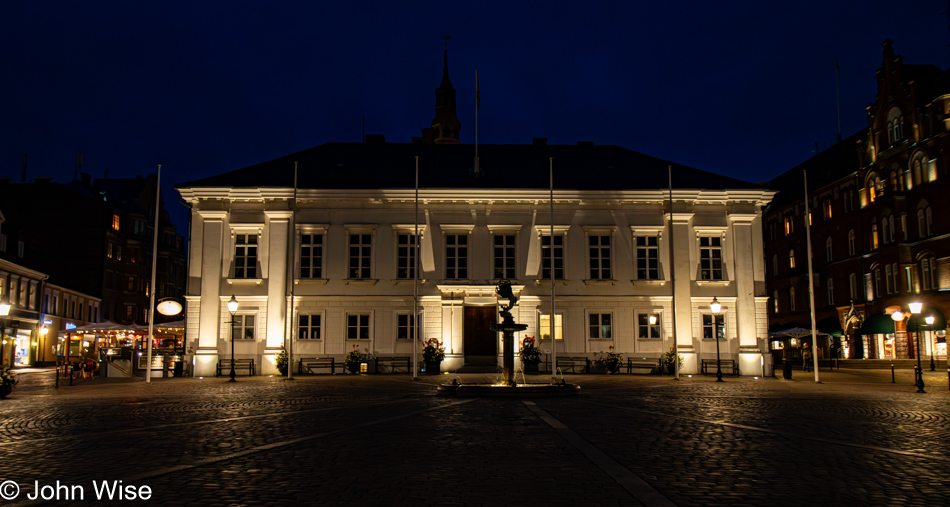
On the left of this white building is Restaurant Store Thor, where we dined on yet more Swedish meatballs in gravy with boiled potatoes, lingonberries, and pickles.
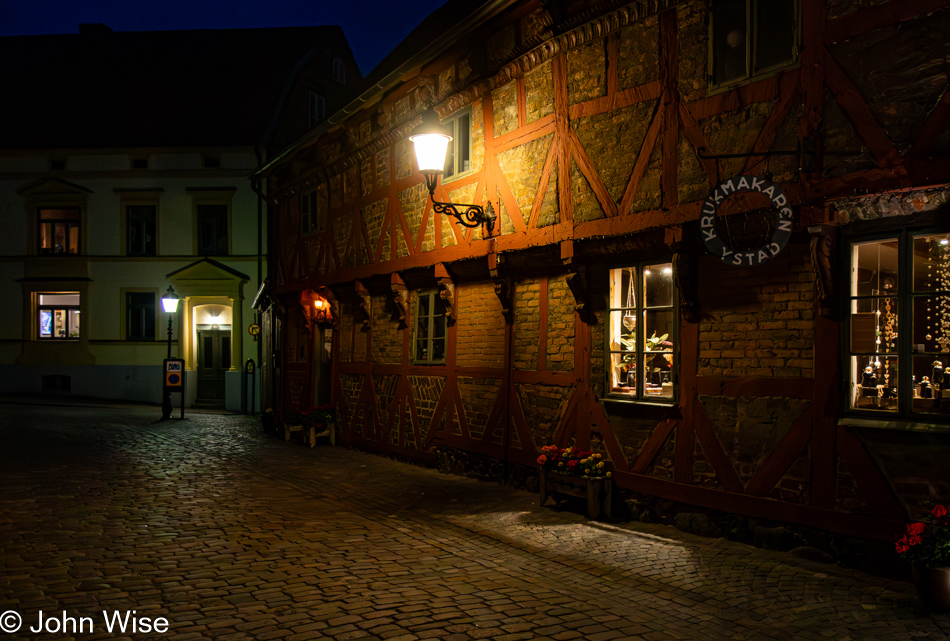
We continued walking around the old town as tomorrow night we’d be staying in yet another city, so this was it for the opportunity to see a little more of Ystad. Soon, though, we needed to end the transmission as we were busy mastering the art of tiredness and needed the use of our hotel to crash into sleep, leaving note-taking for the morning over breakfast.